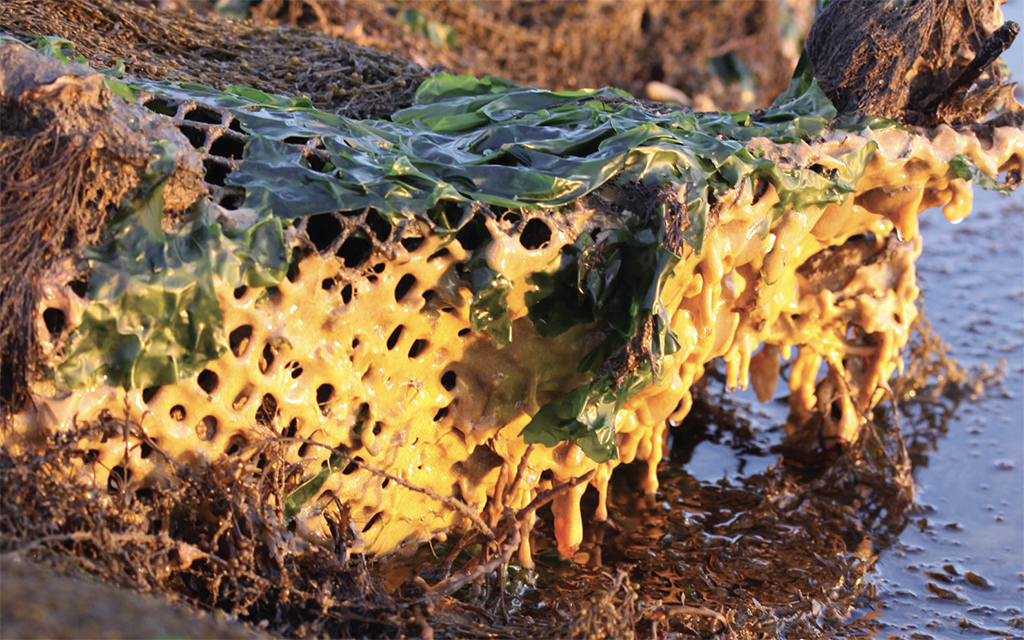
Above: Sea snot, the 'pancake batter' appearance of non-native Didemnum vexillum on lost fishing gear
Becky Hitchin explains how quickly a well-intentioned intervention can impact on coastal marine habitats.
Anyone who has dived in one country over a long period will have seen many changes to the underwater world. These changes are an inevitable part of ongoing evolution, something that occurs naturally without any assistance from humankind. Temperatures cycle, landmasses move, new seas are formed and evolve. But above and beyond these natural rhythms is anthropogenically-induced climate change, and this accentuates change and evolution of marine communities. Also human-based is the introduction of non-native species and invasive species – non-native species that are thought to actively harm the ecosystems they are introduced into.
This is the story of one of those species, the carpet sea squirt, Didemnum vexillum. Otherwise known as sea snot, sea vomit or pancake batter squirt, all fairly accurate descriptions of what it looks like. It took up several years of my life when I was working in Kent when the first intertidal invasion of the UK happened.
'Sea snot' grows over and kills everything in its way, whether that is mussels, oysters, hermit crab shells and even seaweeds
Now, Didemnum vexillum, or D. vex, has an interesting history. It is thought to have originated in Japan, something that was only recently verified through DNA, and over the last 20 years or so, has invaded waters in Europe, North America and New Zealand. D. vex can grow on pretty much anything, including cobbles, boulders, and artificial structures such as boats, dock pilings, and aquaculture equipment. It grows over and kills everything in its way, whether that is mussels, oysters, hermit crab shells and even seaweeds.
So how did it get over here? Maybe not as easily as you’d expect. This is a tale not only of D. vex but another invasive species too. In 1969, the French and Portuguese oyster stocks were largely killed off by a viral disease. To replace the stock, large quantities of Pacific oyster spat (Magellona gigas) were imported from Japan.
Once oyster larvae permanently attach to a surface, they are known as spat. In the early 1970s, spat was also introduced into the Pacific regions of the USA and Canada from Japan. Soon after each introduction, reports were made of a brown colonial squirt invading the oyster beds.
In 2008, the same brown squirt was found in Holyhead Marina, North Wales, likely introduced on the hull of a vessel from Ireland or the Netherlands. Over the winter of 2009, an eradication attempt was made by wrapping up all the marina chains and pontoon structures. Calcium hypochlorite, a bleaching agent, was added to bags to accelerate the process. Unfortunately, though it was thought that the D. vex was eradicated, all the freshly treated surfaces of the marina were rapidly recolonised.
Around 2008, a transfer of spat was made from Brittany to an oyster farm in Kent. A year later, both the seafloor and local intertidal regions were covered in a slimy, tan-coloured squirt, which was quickly identified as D.vex. This was the first invasion intertidally in the UK. In 2009, D. vex was confirmed for the first time in Scotland and has since expanded to sea Loch MPAs, where it is being monitored carefully.
A recent study looked at the genetics of D. vex from all the invasions across the UK. This found high genetic connectivity between marinas situated on opposite sides of the Irish Sea with busy boat traffic between them. Strangford Lough showed high genetic connectivity to an aquaculture site in Kent. It’s thought that movement of oysters between Kent and Strangford Lough for aquaculture may explain the similarity. The moral of this vomit-ridden story? There is one ocean, connected across the world, and we all spend a lot of time on its ports and harbours, in it, and under it. Our actions on any shore, on any interaction underwater, can have consequences that might far outreach our days diving.
Article ‘Uninvited guests’ by Becky Hitchin first published in SCUBA magazine, Issue 144 April 2024.

 Author: Becky Hitchin | Posted 05 May 2024
Author: Becky Hitchin | Posted 05 May 2024



